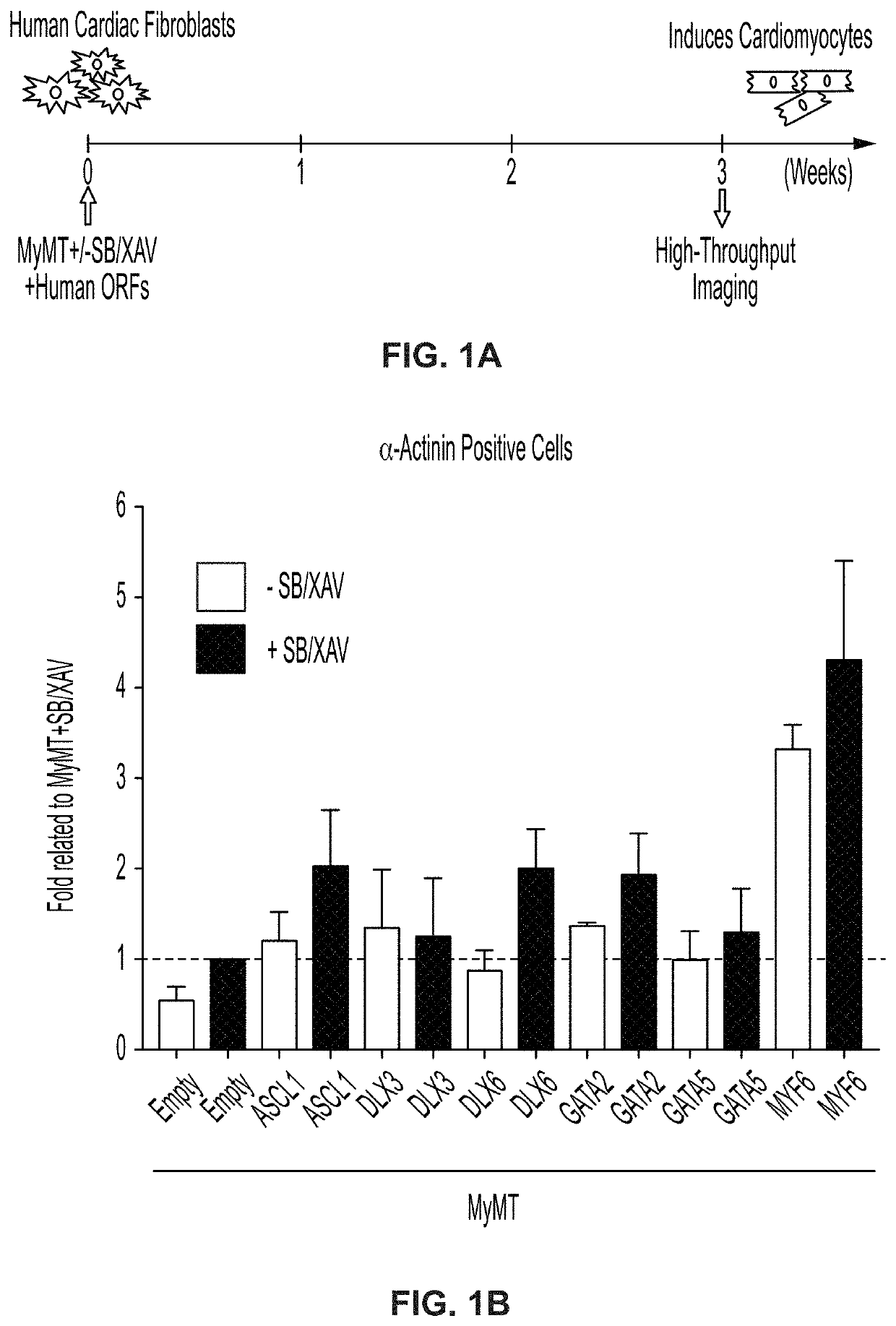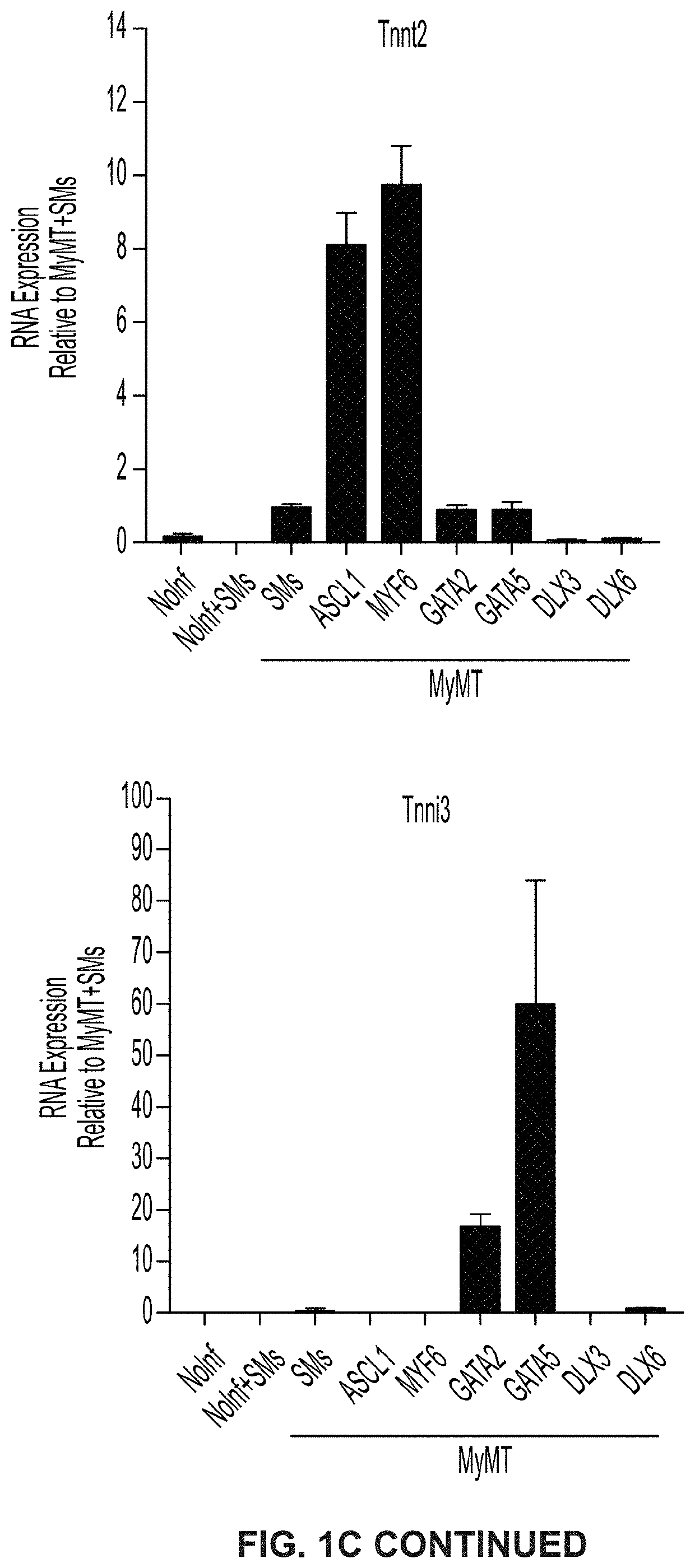Cardiac cell reprogramming with myocardin and ascl1
a technology of myocardin and ascl1, which is applied in the field of gene therapy, cellular reprogramming, and cellular therapy for diseases or disorders of the heart, can solve the problems of limiting the capacity repair itself, and affecting the ability of the heart to regenerate new muscle. , to achieve the effect of increasing the potency
- Summary
- Abstract
- Description
- Claims
- Application Information
AI Technical Summary
Benefits of technology
Problems solved by technology
Method used
Image
Examples
embodiments set 1
[0375]Clause 1-1. Induced cardiomyocyte (iCM) cells, wherein the cells comprise an ASCL1 polynucleotide.[0376]Clause 1-2. The iCM cells of clause 1-1, wherein the cells comprise a MYOCD polynucleotide, a MEF2C polynucleotide, and a TBX5 polynucleotide.[0377]Clause 1-3. The iCM cells of clause 1-2, wherein the ASCL1 polynucleotide and the MYOCD polynucleotide are expressed from a first polycistronic vector; and wherein the MEF2C polynucleotide and the TBX5 polynucleotide are expressed from a second polycistronic vector.[0378]Clause 1-4. The iCM cells of clause 1-3, wherein the first polycistronic vector and the second polycistronic vector are each independently selected from a lipid nanoparticle, a transposon, an adeno-associated virus (AAV) vector, an adenovirus, a retrovirus, an integrating lentiviral vector (LVV), and a non-integrating LVV.[0379]Clause 1-5. The iCM cells of any of clauses 1-2-4, wherein at least 25% of iCM cells are α-actinin positive.[0380]Clause 1-6. The iCM cel...
embodiments set 2
[0407]Clause 2-1. A vector, comprising, in any 5′ to 3′ order and on the same or different polynucleotide strands, a MYOCD polynucleotide and either or both of an ASCL1 polynucleotide or a MYF6 polynucleotide; each polynucleotide operatively linked to at least one promoter.[0408]Clause 2-2. The vector of clause 2-1, wherein the vector comprises, in any 5′ to 3′ order and on the same or different polynucleotide strands, a MYOCD polynucleotide and an ASCL1 polynucleotide.[0409]Clause 2-3. The vector of clause 2-1, wherein the vector comprises, in any 5′ to 3′ order and on the same or different polynucleotide strands, a MYOCD polynucleotide and a MYF6 polynucleotide.[0410]Clause 2-4. The vector of clause 2-1, wherein the vector comprises, in any 5′ to 3′ order and on the same or different polynucleotide strands, a MYOCD polynucleotide; either or both of a MEF2C polynucleotide and a TBX5 polynucleotide; and either or both of an ASCL1 polynucleotide and a MYF6 polynucleotide.[0411]Clause...
embodiments set 3
[0445]Clause 3-1. An isolated polynucleotide, comprising an engineered MYOCD polynucleotide encoding an engineered myocardin protein having a length of at most 850 amino acids, wherein the engineered myocardin protein comprises an SRF interaction domain, an SAP domain, and a TAD domain.[0446]Clause 3-2. The polynucleotide of clause 3-1, wherein the engineered myocardin protein comprises an Mef2c interaction domain.[0447]Clause 3-3. The polynucleotide of clause 3-2, wherein:[0448]Clause 3-4. the Mef2c interaction domain shares at least 85% identity to SEQ ID NO: 17,[0449]Clause 3-5. the SRF domain shares at least 85% identity to SEQ ID NO: 18, Clause 3-6. the SAP domain shares at least 85% identity to SEQ ID NO: 19, and Clause 3-7. the TAD domain shares at least 85% identity to SEQ ID NO: 11.[0450]Clause 3-8. The polynucleotide of clause 3-1 or 2, wherein the engineered myocardin protein comprises an LZ domain.[0451]Clause 3-9. The polynucleotide of clause 3-4, wherein the LZ domain ...
PUM
| Property | Measurement | Unit |
|---|---|---|
| Fraction | aaaaa | aaaaa |
| Length | aaaaa | aaaaa |
| Fraction | aaaaa | aaaaa |
Abstract
Description
Claims
Application Information
 Login to View More
Login to View More - R&D
- Intellectual Property
- Life Sciences
- Materials
- Tech Scout
- Unparalleled Data Quality
- Higher Quality Content
- 60% Fewer Hallucinations
Browse by: Latest US Patents, China's latest patents, Technical Efficacy Thesaurus, Application Domain, Technology Topic, Popular Technical Reports.
© 2025 PatSnap. All rights reserved.Legal|Privacy policy|Modern Slavery Act Transparency Statement|Sitemap|About US| Contact US: help@patsnap.com



